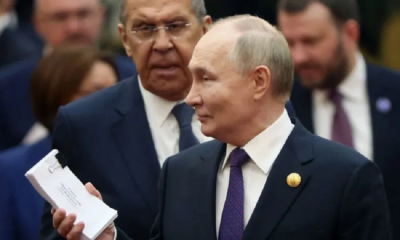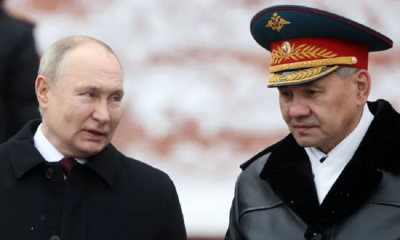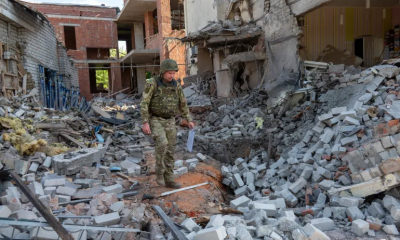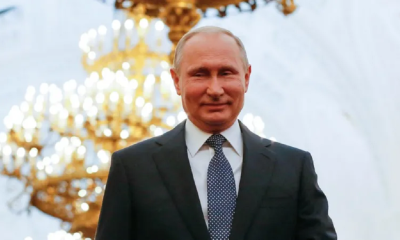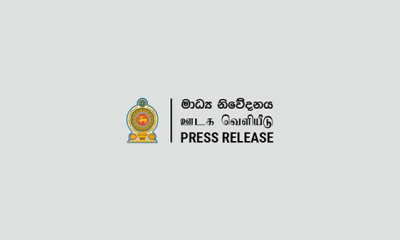Foreign News
Russian authorities say at least 60 killed in Moscow concert hall attack
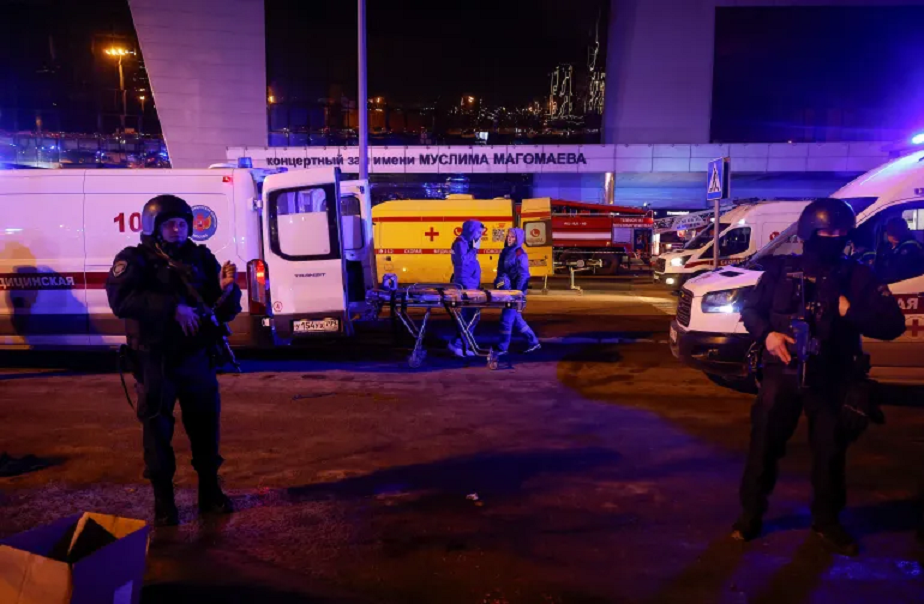
The ISIL (ISIS) group has claimed responsibility for a brazen attack on Moscow’s Crocus City Hall that killed at least 60 people and injured more than 145.
At least five camouflage-clad gunmen with automatic weapons burst into the packed concert hall in the city’s western suburbs on Friday night as the audience was gathering to watch the veteran rock band Picnic, shooting into the crowd and setting off explosives that started a massive fire.
Russian investigators said more than 60 people had been killed. Health officials said about 145 people were injured, and about 60 of them were in critical condition.
ISIL, the hardline group that once sought control over Iraq and Syria, claimed responsibility for the attack on its Telegram channel, saying the gunmen had escaped. It was not possible to independently verify the claim.
The concert hall, one of the most popular in Moscow, can hold some 6,200 people.
Alexei, a music producer, was about to settle into his seat ahead when he said he heard “several machineguns bursts” and “a lot of screams”.
“I realised right away that it was automatic gunfire and understood that most likely it’s the worst: a terrorist attack,” Alexei told the AFP news agency, declining to share his full name.
As people ran towards the emergency exits, “there was a terrible crush” with concertgoers climbing on one another’s heads to get out, he added.
Another witness, speaking to the Reuters news agency, also described the terror and panic inside the venue.
“A stampede began. Everyone ran to the escalator,” they said, declining to share their name. “Everyone was screaming; everyone was running.”
The attack, which left the concert hall in flames and its roof in a state of collapse, was one of the worst in Russia since the 2004 Beslan school siege in which more than 330 people, half of them children, were killed. The death toll appeared set to rise, according to unconfirmed reports.
Moscow Mayor Sergei Sobyanin said Friday’s raid was a “huge tragedy.” President Vladimir Putin was being given continuous updates about the situation, according to his spokesman Dmitry Peskov.
The prosecutor’s office said several men in combat fatigues had entered the concert hall, about 20km (12 miles) from the Kremlin and next to the Moscow ring road, and fired on those inside.
Repeated volleys of gunfire could be heard in videos posted by Russian media and on Telegram channels. One showed two men with rifles moving through the venue. Another showed a man in the auditorium saying the assailants had set it on fire, as repeated gunshots rang out in the background.
Others showed up to four attackers, armed with assault rifles and wearing caps, shooting screaming people at point-blank range.
Security guards at the concert hall were not armed, and Russian media said some could have been killed at the start of the attack.
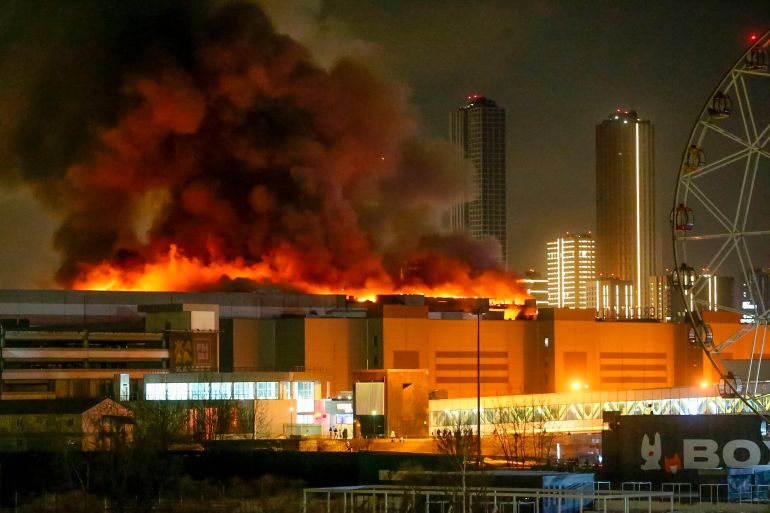 The concert venue, one of the most popular in Moscow, was engulfed in flames (Aljazeera)
The concert venue, one of the most popular in Moscow, was engulfed in flames (Aljazeera)
ISIL claimed responsibility in a statement posted by its Amaq news agency, saying its fighters had attacked on the outskirts of Moscow, “killing and wounding hundreds and causing great destruction to the place before they withdrew to their bases safely”. The statement gave no further detail.
Russia has reported several incidents involving ISIL this month, with authorities saying they killed six alleged members of the group in a shootout in Ingushetia in the restive Caucasus region, and the FSB saying on March 7 it foiled an attack by Islamic State in Khorasan Province (ISKP), an Afghan affiliate of ISIL, on a Moscow synagogue.
The United States has also warned of the heightened threat. Several hours after the FSB announcement, the US embassy in Moscow issued a warning that “extremists” had imminent plans for an attack in Moscow. On Friday night, a US official said Washington had intelligence confirming ISIL’s claim of responsibility for the attack on Crocus City Hall.
Earlier, Russian Foreign Ministry spokeswoman Maria Zakharova said what had happened was a “bloody terrorist attack”. Investigators from Russia’s Investigative Committee, which deals with major crimes, said they had “opened a criminal probe under article 205 of the criminal code [terrorist act]”.
There was condemnation of the attack from across the world.
United Nations Secretary-General Antonio Guterres expressed his shock at the attack, which his spokesman said he “condemns in the strongest possible terms”, while the UN Security Council condemned what it called a “heinous and cowardly terrorist attack.”
French President Emmanuel Macron “strongly condemns the terrorist attack claimed by the Islamic State”, the Elysee Palace said.
“France expresses its solidarity with the victims, their loved ones and all the Russian people.”
Spain said it was “shocked” at events in Moscow, while Italian Prime Minister Giorgia Meloni condemned what she said was an “odious act of terrorism” and expressed her “full solidarity with the affected people and the victims’ families”.
Russian officials said security has been tightened at Moscow’s airports, railway stations and on the metro system. The mayor cancelled all mass gatherings, while theatres and museums in the area, home to more than 21 million people, were ordered shut for the weekend. Other Russian regions also tightened security.
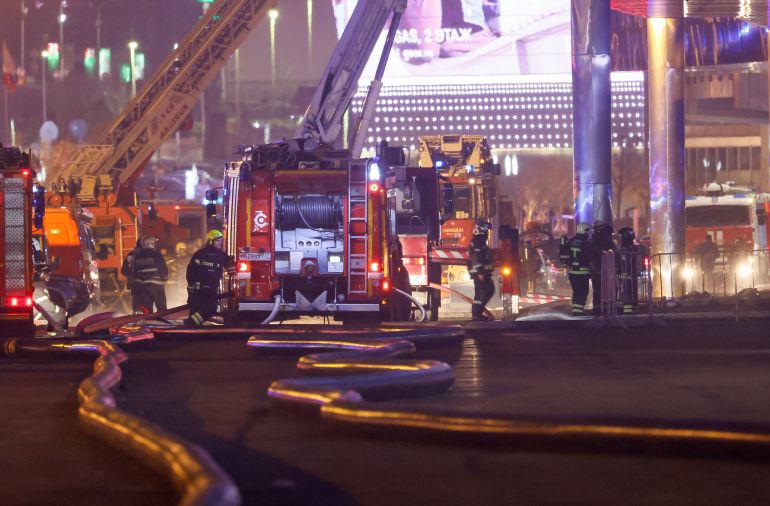 Firefighters work near the burning Crocus City Hall concert venue. The fire was mostly extinguished by early on Saturday morning (Aljazeera)
Firefighters work near the burning Crocus City Hall concert venue. The fire was mostly extinguished by early on Saturday morning (Aljazeera)
The Kremlin did not immediately blame anyone for the attack, but some Russian lawmakers were quick to accuse Ukraine.
Former Russian President Dmitry Medvedev wrote on the Telegram app that if those responsible for the attack turn out to be Ukrainian, “all of them must be found and ruthlessly destroyed as terrorists”.
Mykhailo Podolyak, an adviser to Ukrainian President Volodymyr Zelenskyy, denied Ukraine’s involvement.
“Ukraine has never resorted to the use of terrorist methods,” he posted on X. “Everything in this war will be decided only on the battlefield.”
Rosgvardia, Russia’s national guard, said it was searching for the perpetrators of the attack, and its units were helping evacuate concertgoers from the burning building.
Rescue services had evacuated about 100 people from the basement of the Crocus City Hall, but there are still people on the roof, Russian news agencies reported.
Media reports said firefighters were trying to contain the fire, as plumes of black smoke rose above the venue into the night sky. Helicopters were also deployed in an attempt to douse the flames that had engulfed the building.
In the early hours of Saturday morning, authorities said most of the fire had been put out. “There are still some pockets of fire, but the fire has been mostly eliminated. Rescuers were able to enter the auditorium,” Moscow Governor Andrey Vorobyov said on Telegram.
(Aljazeera)
Foreign News
Nasa ‘Earthrise’ astronaut dies at 90 in plane crash

Apollo 8 astronaut Bill Anders, who snapped one of the most famous photographs taken in outer space, has died at the age of 90.
Officials say a small plane he was flying crashed into the water north of Seattle, Washington.
Anders’ son Greg confirmed that his father was flying the small plane, and that his body was recovered on Friday afternoon. “The family is devastated. He was a great pilot. He will be missed,” a statement from the family reads.
Anders – who was a lunar module pilot on the Apollo 8 mission – took the iconic Earthrise photograph, one of the most memorable and inspirational images of Earth from space.
Taken on Christmas Eve during the 1968 mission, the first crewed space flight to leave Earth and reach the Moon, the picture shows the planet rising above the horizon from the barren lunar surface.
Anders later described it as his most significant contribution to the space programme.
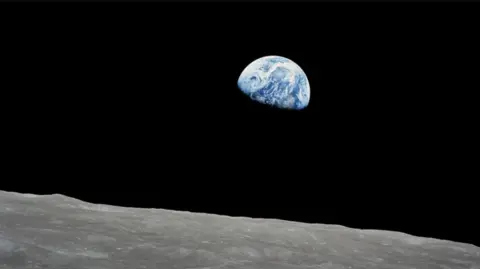
The image is widely credited with motivating the global environmental movement and leading to the creation of Earth Day, an annual event to promote activism and awareness of caring for the planet.
Speaking of the moment, Anders said: “We came all this way to explore the Moon, and the most important thing that we discovered was the Earth.”
Officials said on Friday that Anders crashed his plane around 11:40PDT (1940BST).
The US National Transportation Safety Board (NTSB) said the 90-year-old was flying a Beechcraft A A 45 – also known as a T-34. The agency said that the plane crashed about 80ft (25m) from the coast of Jones Island.
Anders also served as the backup pilot to the Apollo 11 mission, the name of the effort that led to the first Moon landing on July 24, 1969.
Following Anders’ retirement from the space programme in 1969, the former astronaut largely worked in the aerospace industry for several decades. He also served as US Ambassador to Norway for a year in the 1970s.
But he is best remembered for the Apollo 8 mission and the iconic photograph he took from space.
“In 1968, during Apollo 8, Bill Anders offered to humanity among the deepest of gifts an astronaut can give. He traveled to the threshold of the Moon and helped all of us see something else: ourselves,” Nasa Administrator Bill Nelson said in a statement.
Mark Kelly, a former astronaut who now serves as a US Senator for the state of Arizona, said in a post on X, formerly Twitter, that Anders “inspired me and generations of astronauts and explorers. My thoughts are with his family and friends”.
[BBC]
Foreign News
China’s Chang’e-6 lifts off from far side of Moon with rock samples

A Chinese spacecraft carrying rock and soil samples from the far side of the Moon has lifted off from the lunar surface to start its journey back to Earth, according to state media.
The achievement on Tuesday is a world first and the latest leap for Beijing’s decades-old space programme, which aims to send a crewed mission to the Moon by 2030.
The Xinhua News Agency, citing the China National Space Administration (CNSA), said that the ascender of the Chang’e-6 probe took off at 7:38am local time on Tuesday (23:38 GMT) and entered a preset orbit around the moon.
It described the move as “an unprecedented feat in human lunar exploration history”.
The Chang’e-6 probe was launched last month and its lander touched down on the far side of the Moon on Sunday. It used a drill and robotic arm to dig up soil on and below the Moon’s surface, according to Xinhua.
After successfully gathering its samples, the Chang’e-6 unfurled China’s national flag for the first time on the far side of the Moon, it said.
The agency cited the CNSA as saying that the spacecraft stowed the samples it had gathered in a container inside the ascender of the probe as planned.
[Aljazeera]
Foreign News
China says its spacecraft lands on Moon’s far side

China says its uncrewed craft has successfully landed on the far side of the Moon – an unexplored place almost no-one tries to go.
The Chang’e 6 touched down in the South Pole-Aitken Basin at 06:23 Beijing time on Sunday morning (22:23 GMT Saturday), the China National Space Administration (CNSA) said.
Launched on 3 May, the mission aims to collect precious rock and soil from this region for the first time in history. The probe could extract some of the Moon’s oldest rocks from a huge crater on its South Pole.
The landing was fraught with risks, because it is very difficult to communicate with spacecraft once they reach the far side of the Moon. China is the only country to have achieved the feat before, landing its Chang’e-4 in 2019.
After launching from Wenchang Space Launch Center, the Chang’e 6 spacecraft had been orbiting the Moon waiting to land. The lander component of the mission then separated from the orbiter to touch down on the side of the Moon that faces permanently away from Earth.
During the descent, an autonomous visual obstacle avoidance system was used to automatically detect obstacles, with a visible light camera selecting a comparatively safe landing area based on the brightness and darkness of the lunar surface, the CNSA was quoted as saying by state-run Xinhua news agency.
The lander hovered about 100m (328ft) above the safe landing area, and used a laser 3D scanner before a slow vertical descent. The operation was supported by the Queqiao-2 relay satellite, the CNSA said.
Chinese state media described the successful landing as an “historic moment”. The state broadcaster said “applause erupted at the Beijing Aerospace Flight Control Center” when the Chang’e landing craft touched down on the Moon early on Sunday morning.
The lander should spend up to three days gathering materials from the surface in an operation the CNSA said would involve “many engineering innovations, high risks and great difficulty”. “Everyone is very excited that we might get a look at these rocks no-one has ever seen before,” explains Professor John Pernet-Fisher, who specialises in lunar geology at the University of Manchester.
He has analysed other lunar rock brought back on the American Apollo mission and previous Chinese missions. But he says the chance to analyse rock from a completely different area of the Moon could answer fundamental questions about how planets form.
Most of the rocks collected so far are volcanic, similar to what we might find in Iceland or Hawaii. But the material on the far side would have a different chemistry . “It would help us answer those really big questions, like how are planets formed, why do crusts form, what is the origin of water in the solar system?” the professor says.
The mission aims to collect about 2kg (4.4lb) of material using a drill and mechanical arm, according to the CNSA.
The South Pole–Aitken basin, an impact crater, is one of the largest known in the solar system.
From there, the probe could gather material that came from deep inside the lunar mantle – the inner core of the Moon – Prof Pernet-Fisher says.
The Moon’s South Pole is the next frontier in lunar missions – countries are keen to understand the region because there is a good chance it has ice.
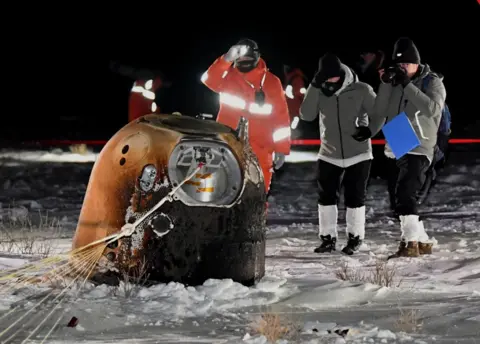
The capsule in the last Chinese moon mission, Chang’e 5, brought back soil and rocks in 2020 (BBC)
Access to water would significantly boost the chances of successfully establishing a human base on the Moon for scientific research.
If the mission succeeds, the craft will return to Earth with the precious samples on board a special return capsule.
The material will be kept in special conditions to try to keep it as pristine as possible.
Scientists in China will be given the first chance to analyse the rocks, and later researchers around the world will be able to apply for the opportunity too.
This is the second time China has launched a mission to collect samples from the Moon.
In 2020 Chang’e 5 brought back 1.7kg of material from an area called Oceanus Procellarum on the Moon’s near side.
China is planning three more uncrewed missions this decade as it looks for water on the Moon and investigates setting up a permanent base there.
Beijing’s broader strategy aims to see a Chinese astronaut walk on the moon by around 2030.
The US also aims to put astronauts back on the moon, with Nasa aiming to launch its Artemis 3 mission in 2026.
(BBC)


